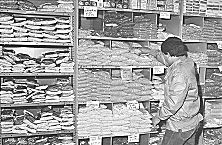| Entries |
| I |
|
Indians
|

|
Despite their affluence and professional status, Indians have never had a presence in Chicago politics and have been relatively isolated socially. Many are, nonetheless, employed by the city and the state. They do not lack organizations: a pamphlet released in 1995 by the Vishwa Hindu Parishad, an organization that advocates pride in Hindu culture and the political ascendancy of Hinduism, lists nearly 70 Indian associations in the greater Chicago area, not including those catering to Muslims. Several temples serve the Hindu community; there are two gurudwaras for Sikhs and one major Jain temple; and Indian Muslims frequent several mosques. Indian Christians and Zoroastrians (Parsis) are also well organized. The ethnic, linguistic, and cultural divisions that prevail in India have been carried over with organizations such as the Bengali Association, the Bihar Cultural Association, the Tamilnadu Foundation, the Telugu Association, the Punjabi Cultural Society, the Maharashtra Mandal, and at least three Gujarati associations. Other organizations strive to evoke a more comprehensive notion of “Indianness”: prominent among these are the Indian Classical Music Circle, which sponsors recitals by major Indian musicians, and the Chicago chapters of various professional organizations of Americans of Indian origin. Until the 1980s, no organization addressed adequately the problems encountered by Indian women, many of them unacquainted with legal and social services. Apna Ghar was set up in 1989–90 to meet this need as a shelter for battered Indian women and counseling service.
A section of Devon Street, near the northwestern suburbs, provides a glimpse of Indian life. Indian restaurants proliferate, as do Indian grocery stores, boutiques, and jewelry shops. Here, as elsewhere in the Indian diaspora, commercial Hindi films are extremely popular and may well be the element that cements Chicago's diverse Indian population into a more cohesive identity. The growing strength of Indians is indicated by the fact that in 1991 the “Little India” stretch of Devon was also designated Gandhi Marg (Way), which in turn prompted Pakistanis to press for the redesignation of an adjoining stretch to Mohammed Ali Jinnah Way in memory of the founder of Pakistan.
The Encyclopedia of Chicago © 2004 The Newberry Library. All Rights Reserved. Portions are copyrighted by other institutions and individuals. Additional information on copyright and permissions.